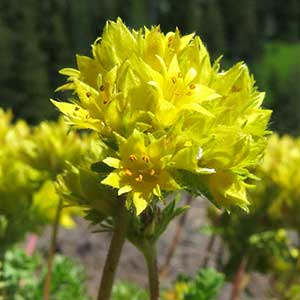Ivesia gordonii
Ivesia webberi
alpine ivesia, alpine mousetail, Gordon's ivesia
Webber's ivesia, wire ivesia, wire mousetail
prostrate to erect, (0.2–)0.5–4 dm.
decumbent to ascending, 0.5–1.5(–1.8) dm.
tightly to loosely cylindric, (1–)3–20(–25) cm; sheathing base ± glandular abaxially, otherwise glabrous;
petiole 0.5–8 cm, hairs 0.2–0.5 mm;
leaflets (6–)10–25 per side, (1–)2–13(–18) mm, glabrous or ± hirsute or villous, glandular-puberulent or -pubescent, lobes (2–)4–8(–15), linear or narrowly oblanceolate to obovate, apex rarely setose.
loosely ± cylindric, 3–7(–10) cm; sheathing base ± strigose abaxially;
petiole 0.5–5(–6) cm, hairs 2–4 mm;
leaflets 4–8(–10) per side, (0.5–)3–8(–10) mm, loosely long-strigose or -villous and short-hirsute, ± glandular, lobes 2–5(–12), linear to lanceolate, apex not setose.
1(–2), not paired.
2, paired.
5–50(–70)-flowered, 1–8(–11) cm diam.;
glomerules 1–several.
5–15(–25)-flowered, 1.5–3(–6) cm diam.;
glomerules 1.
1–3(–5) mm.
(0.5–)1–8(–13) mm.
5–12 mm diam.;
epicalyx bractlets linear to narrowly elliptic, (0.5–)1–3.5(–4) mm;
hypanthium turbinate to campanulate, (1.5–)2–4(–4.5) × 2–4(–5) mm;
sepals (2–)2.5–5(–6) mm, obtuse to ± acute;
petals yellow, narrowly oblanceolate to narrowly spatulate, (1–)1.5–3 mm;
stamens 5, filaments 1.3–2.5 mm, anthers yellow, sometimes red-margined, 0.5–1 mm;
carpels (1–)2–4(–6), styles 2.5–4.5(–6) mm.
9–12 mm diam.;
epicalyx bractlets linear, 1.2–3 mm;
hypanthium cupulate, 1–2(–2.5) × 2.5–5 mm;
sepals 2.5–4.5(–5.5) mm, acute;
petals yellow, narrowly oblanceolate, 2–3(–4) mm;
stamens 5, filaments 1.8–2.5(–3) mm, anthers yellow, (0.8–)1–1.6 mm;
carpels 3–8, styles 1.8–2.2 mm.
grayish brown to mottled brown, ± 2 mm.
light brown, often mottled darker brown, 1.9–2.5 mm.
Ivesia gordonii
Ivesia webberi
Varieties 4 (4 in the flora).
Ivesia gordonii is the most widespread species of the genus, occurring from Washington to Montana, south to central California and Colorado. The species can be distinguished from other members of sect. Ivesia by the relatively deep hypanthium, which is about as deep as wide. Four varieties are provisionally recognized here (B. Ertter and J. L. Reveal 2007), with the likelihood that future work may indicate additional and/or alternate circumscriptions. Populations that are difficult to assign to a variety can be found where the recognizable taxonomic units come together, for example, in northeastern Utah and western Wyoming, involving var. gordonii and var. wasatchensis, and in California and central Idaho where var. alpicola and var. ursinorum tend to merge.
(Discussion copyrighted by Flora of North America; reprinted with permission.)
Of conservation concern.
Ivesia webberi is known only from the eastern foothills of the northern Sierra Nevada and scattered ranges to the east in California and adjacent Nevada. It is among the more distinctive species in the genus and is only tentatively placed in sect. Ivesia. The leaflets are loosely incised into slender, sparsely villous segments, and the two cauline leaves are paired with dissected stipules. Previous reports of the stems and inflorescence branches being glandular-puberulent are due to a misinterpretation of the minute pustulose bases associated with the villous indumentum as being enlarged glands.
(Discussion copyrighted by Flora of North America; reprinted with permission.)
1. Leaflets 7–13(–18) mm, glabrous or sparsely hirsute or villous marginally; stems (1–)1.5–4 dm; inflorescences usually branched, 2–8(–11) cm diam., glomerules (1–)2–6(–10), ± capitate. | var. wasatchensis |
1. Leaflets (1–)2–7(–9) mm, hairy or ± glabrous except marginally ciliate; stems (0.2–)0.5–2.5 dm; inflorescences simple or branched, 1–3(–5) cm diam., glomerules 1(–3), ± capitate to loosely congested | → 2 |
2. Stems usually prostrate to ascending, rarely nearly erect, usually dark reddish, minutely glandular or glandular-puberulent to -pubescent; leaves to 0.8 cm diam.; anthers usually red-margined. | var. ursinorum |
2. Stems usually ascending to erect, sometimes decumbent, usually greenish, rarely reddish, hirsute to villous, glandular-puberulent to -pubescent; leaves to 1.5 cm diam.; anthers rarely red-margined | → 3 |
3. Stems usually hirsute to villous, sometimes densely so, glandular-pubescent or eglandular; basal leaves (3–)5–10(–15) cm; flowers 7–12 mm diam.; e Idaho and w Montana to Utah, Wyoming, and w Colorado. | var. gordonii |
3. Stems not or sparsely hirsute to villous, glandular-puberulent or -pubescent; basal leaves 2–8(–10) cm; flowers 5–9 mm diam.; s Washington to California and e to w Montana. | var. alpicola |


